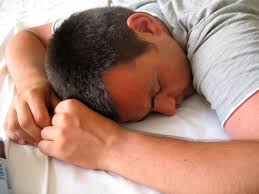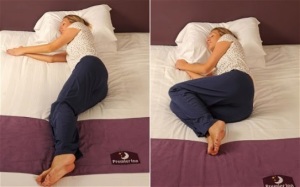What is the best way to sleep?
When you’re asleep during the night, what is the position of your body? Do you turn over onto one side, crunched up in a ball like a fetus in the womb, or do you roll over on your back, arms at your side like a solider?
Though a sleeper may find it difficult to record their posture for obvious reasons, there are “good” and “bad” ways to sleep. The cause of aches and pains or many sleepless nights (which can lead to a bunch of other negative risks) may have a lot do with the placement of your head, back, arms, and legs after you hit the hay.
“It is clinically accepted that a change in sleep position may benefit the systematic health of individuals,” Australian researchers wrote in a 2007 study published in the peer-reviewed publication, “The Internet Journal of Allied Health Sciences and Practice.”
The best sleeping position by far is either on the back or the side. It doesn’t matter if you sleep on your left or right side, unless you’re pregnant. Both of these positions support the spine and the neck, leading to a more restful night’s sleep and helping to prevent injuries in the long run.

On your back
Sleeping on your back ensures proper circulation to the brain, maintains your back and neck in a neutral position, and fights acid reflux—all great reasons to back-sleep. Looking for beauty rest? It helps with that too, preventing wrinkles (because nothing is pushing against your face all night).
It is recommended to place a pillow under the knees, placing the legs in a more direct line with the lower back spine so that it’s flattened against the mattress and receives more support. It’s best to keep the arms down at your side, not sprawled o
ver your head. Having your arms over your head will cause issues with the shoulders, neck and upper back.
The one drawback of sleeping on your back is that it may exacerbate snoring. People who suffer from sleep apnea are also advised to avoid this position.
That said, it’s not the ideal position for snorers, making the base of your tongue collapse to the back wall of your throat, causing a vibrating sound—try sleeping on your side to combat that.
Picture 1 is correct, what is wrong with picture 2?
On your side
When a person is laying on either the left or right side, it’s best to slightly bend the upside leg and place a pillow between the knees. This keeps the pelvis in a straight line and prevents unnatural twisting.
In addition to side-sleeping reducing snoring, sleeping on one’s left side also eases heartburn and acid reflux, making it easier to fall and stay asleep.
It’s a great option during pregnancy too, when back sleeping puts too much pressure on the spine. Sleeping on one’s left side during pregnancy improves circulation to the heart—doctors even recommend it since it’s so good for both Mom and baby.
When you are on your side you should not put your hands under your pillow or raise them above shoulder height. Your arms should be folded directly in front of your torso. If you do place your hands under your pillow this is normally a sign that the pillow is too low!
BAD: Stomach sleeping position
The worst position to sleep in is on your stomach! There is a consensus that the prone sleep position should be avoided from numerous health studies. If a person is lying with their belly down and face pressed into the pillow, they must crane their neck in order to breathe which can begin to strain the vertebrae in the bottom part of your skull after just 15 minutes. Sleeping on your stomach reverses the neck, mid back and lower back curve, places stress on the hips, knees and feet!
It’s a natural tendency, too, for the person to then bend the knee and hip of the same side to which the head is turned, and bring that leg up. This causes an unnatural lateral, or outward, rotation of that leg that, and overtime leads to a chronic lateral hip rotation on that side
Think about the soreness you’d feel if you kept your neck turned to one side for 15 minutes during the day! In this position you have your head to one side for hours at a time. You won’t necessarily feel it the next day, but you may soon start to ache.
Unfortunately many adults find stomach-sleeping the most comfortable position because they grew up during a time when mothers were told to place their babies’ tummies-down and have kept that habit through adulthood.
To break that sleeping pattern I advise patients to initially place one pillow under your abdomen and allow yourself to sleep on your stomach. Then over time add an additional pillow until such time you are lying on your side with pillow propped in front of you to avoid rolling to your stomach. The other suggestion I have for patients is to tie a towel around their waist and to knot the towel at the front.
The stomach-sleeping position also puts stress and joints and muscles, leading to nerve irritation and pain, tingling, and numbness. It may feel comfortable, but sleeping with your body curved in the fetal position restricts breathing and compresses vital organs.
Common items I discuss with patients regularly that place undo stress on their bodies:
Pulling the knees up: You may feel it in the morning when you sleep with your knees pulled up high and chin tucked into your chest especially if you have an arthritic back or joints. You should try not to tuck them up too far.
Arms under your pillow or above your head:


This normally indicates your pillow is too low if your arms are under your pillow! Having your arms under your pillow will aggravate your upper back, shoulders, elbows, wrists and hands. To break this habit you should: raise the pillow up by placing a folded towel under the pillow. Take another pillow and hug it in front of your torso. Any questions feel free to ask me.
Your arms above your pillow will place a lot of stress on the shoulders and upper back.
Your Pillow: If it is too hard or bulky your pillow will not support the “C” curve of the neck. If that curve is diminished it won’t support the head, leading to neck pain and other problems. Your pillow should be at the correct height to keep your head and neck in alignment. The easiest way for you to determine this is to lie on your side and have someone see if your head stays straight. If it does not and it tips down then the pillow is too low and vice versa.
Pillows do wear out with use, the same as your footwear wearing out with use! I tell patients’ often to have a look at their pillows to ensure they are still supporting them. Generally a pillow lasts 2 years. I also recommend to patients’ after purchasing a new pillow to: mark on the date on the pillow and when they change the pillow case it will remind you of the age of the pillow. As well if they make use of an electronic agenda to mark the date of purchase in the agenda and as well a year after purchase to a reminder to check the pillow and on subsequent months’ as well.
I have many patients’ that do not realize that a major part of their neck, shoulder, and back issues is either the age of their pillow or mattress.
At Back to Health Wellness Centre we do have pillows that we loan out for trying before purchasing one. If you would like to do this please speak with front reception.
Your mattress:
A mattress normally lasts only 10-12 years. It is important to check the mattress regularly when changing the sheets for wear, bumps, lumps, and indents. If you are wondering if the mattress is starting to have a slight divot in it then take a leveller or broom stick and place it across the mattress to see if it is level. You should also turn and possibly flip (if the mattress allows this) the mattress every 3-4 months’.
If you are purchasing a new mattress feel free to ask me what the best type is for your body type.

Based on the article what is this woman doing that she should change?
If you have any questions regarding your sleep positions, pillows, mattresses or anything else with your sleep feel free to email me at: dr.rodwin@back2health4you.com. Enjoy your sleep!
Yours in Health,
Dr. Barbara Rodwin, D.C., B.Sc., D.Ac., ART
Doctor of Chiropractic, Cranial Adjustor, Acupuncturist, Biomechanics specialist and Active Release Technique Provider
240 Catherine St., Suite 100
Ottawa, ON K2P 2G8
T: 613.237.3306
F: 613.237.3100
Twitter: https://twitter.com/back2health4you
Facebook: https://www.facebook.com/Back2Health4you







